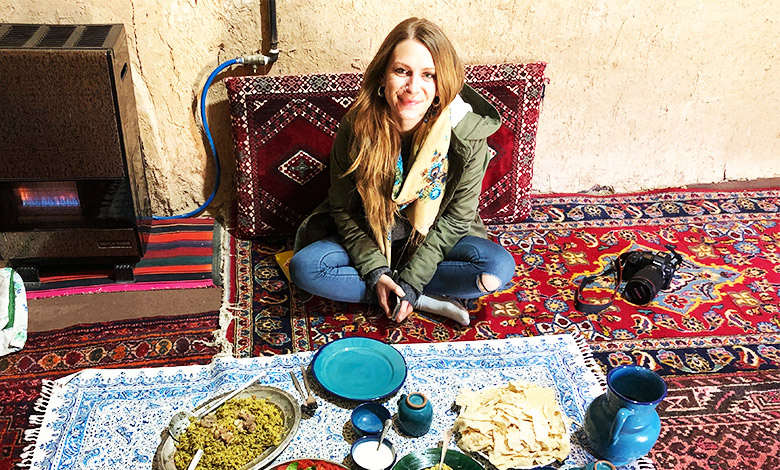
From the earliest times Persians have been known for their hospitality, whether that of the tribesman offering rest and refreshment to a weary traveler, or that of the urbane city dweller offering a sumptuous repast to his guests.
Tradition requires that guests or visitors be served only the finest food available, and always in the most bountiful manner possible. Accounts of early travelers to Iran indicate that the dishes served have not changed appreciably over the centuries.
Persia’s geography, history and cultural influences have shaped the diversity of ingredients and the methods of cooking in one of the world’s oldest and most sophisticated cultures. Persia – or Iran – has been subjected to repeated invasions, but it has maintained its culture, language and identity throughout the centuries.
The vast size of the country encompasses a wide array of local dialects, lifestyles, regional traditions and customs, not to mention an extraordinary variety of landscapes and climates.
All these are reflected in the country’s food. In the north, around the southern coast of the Caspian Sea, the landscape is lush and green and as a result of plentiful rainfall there is great diversity of fruit, vegetables and herbs.
The northern regional cuisine features simple, fresh notes of taste and aroma, and there is a preference for sweet and sour flavours, as opposed to spicy. Further south, in the provinces near the Persian Gulf, where the climate is drier, the season for fresh ingredients is much shorter and the variety available is not as great.
There is also a long tradition of trade through the sea routes with spice-rich countries like India. The resulting cuisine is more complex in taste than in the north of the country, with long notes of spices, tamarind and chillies.
In this post I’m going to take you through top foods you must try when you’re visiting Iran.
Contents
1. Khoresht-e Fesenjan: A Classic Persian Food
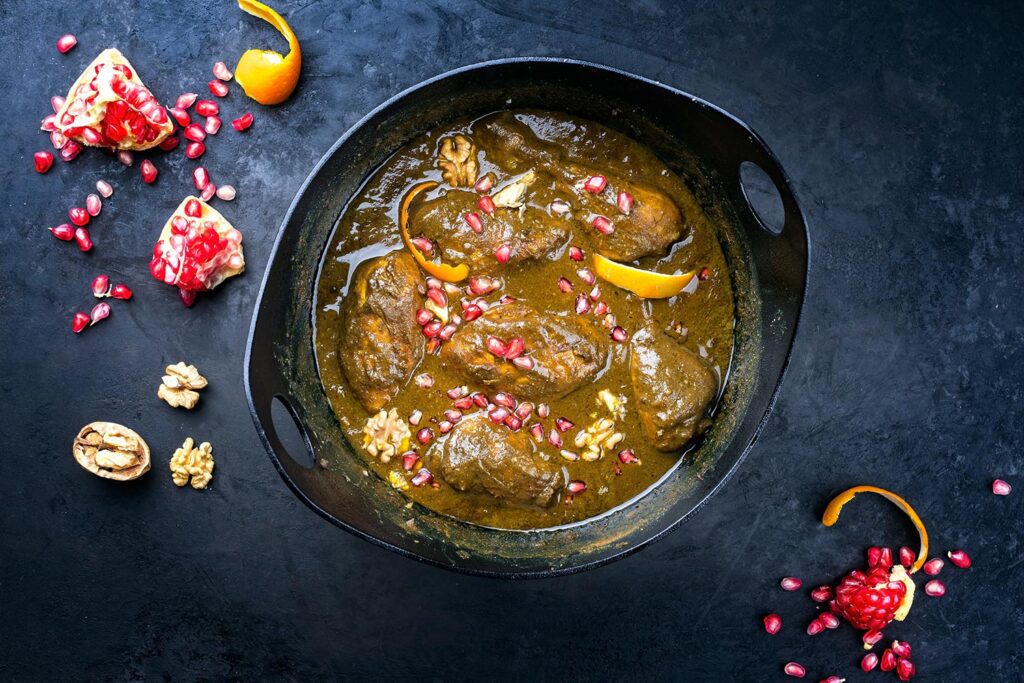
This iconic stew, a key element of Persian food, is an essential part of every Persian wedding menu. Khoresht-e fesenjan traditionally made with duck, this dish also works well with chicken or lamb.
In the north of Iran it is sometimes made with fish. It is a relatively easy khoresht to make, but it must be cooked slowly to allow the flavours to develop in the sauce. The consistency should be thick and creamy and the colour almost black. The distinctive flavour combines the nutty taste of ground walnuts with the sweet and sour flavour of pomegranate syrup.
Khoresht-e Fesenjan Ingredients
- 2 tablespoons olive oil
- 1 1/2 pounds chicken legs, cut up
- 1 white onion, thinly sliced
- 1/2 pound walnuts, toasted and finely ground in a food processor
- 1 teaspoon salt
- 4 cups pomegranate juice
- 1/2 teaspoon cardamom (optional)
- 2 tablespoons sugar (optional)
2. Zereshk Polo
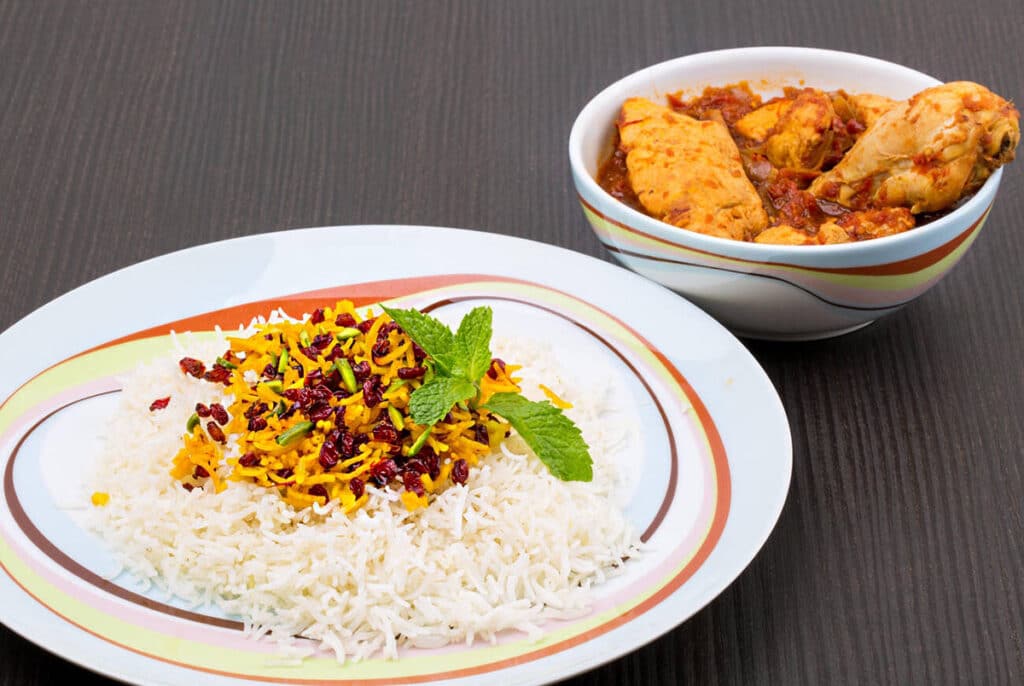
The sweet and sour flavour of zereshk (barberries) and the glistening ruby red berries set against the white and saffron tinged grains make this a feast for the taste buds and the eyes.
Iranian barberry rice, or Zereshk polo, a Persian food, is popular at celebrations, known for its impressive look and easy preparation for large groups. Zereshk polo is usually served with chicken.
Zereshk Polo Ingredients
- 1 medium onion
- 2-3 chicken breasts
- Liquid saffron
- Sugar (3-4 spoons usually is enough)
- 3 cups rice – soak in salt water after washing the rice
- 1 cup zereshk (barberries)
- Salt/Pepper
- Turmeric
- Oil
3. Khoresht-e Ghormeh Sabzi
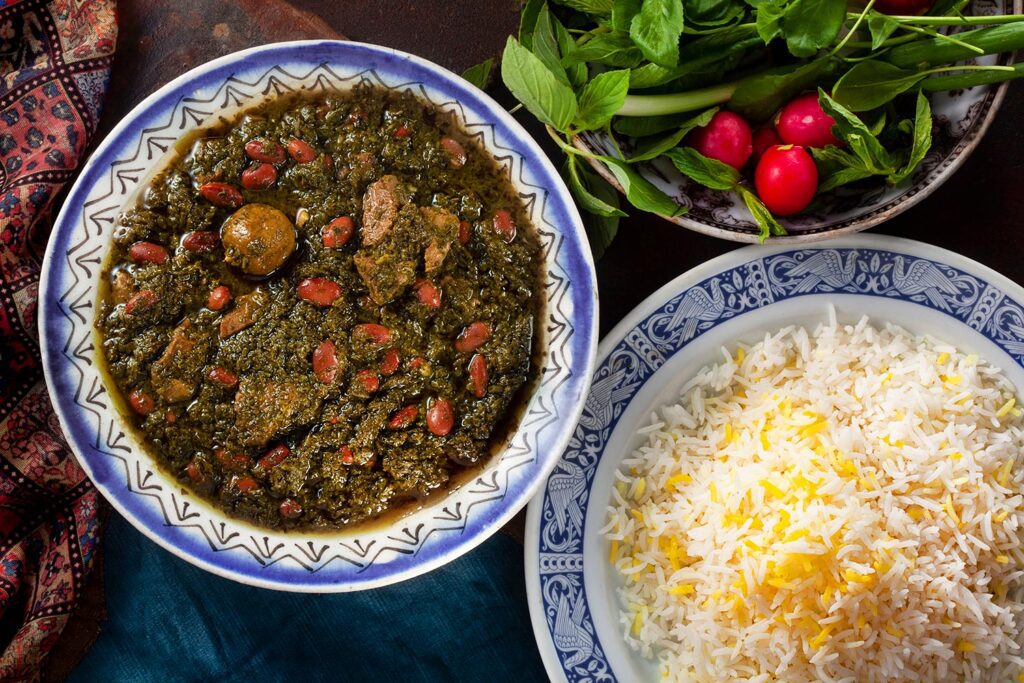
Khoresht-e ghormeh sabzi, a classic traditional Persian food, is sour and bursting with aromatic herbs. A popular favorite throughout Iran, this dish is a staple for festive occasions and family meals. Recipes from different regions may vary slightly; for instance, the Azerbaijani version substitutes black-eyed beans for red kidney beans.
Recipes in the south of the country add chilli and garlic, while in Shiraz potatoes are sometimes used instead of beans. The recipe here departs from tradition by adding spinach to enhance the taste and give the dish a softer texture. Fenugreek gives a very distinctive aroma and flavour.
Ghormeh Sabzi Ingredients
- 1 onion
- 4 cloves garlic
- 1 tsp turmeric
- 1 lb. stewing meat
- 4 dried Persian limes
- 1/3 cup kidney beans, dried
- 4 cups fresh parsley, packed
- 2 cups fresh cilantro, packed
- 1 cup fresh fenugreek
- 2 cups fresh chives
- Salt/Pepper
- Oil
4. Sabzi Polo
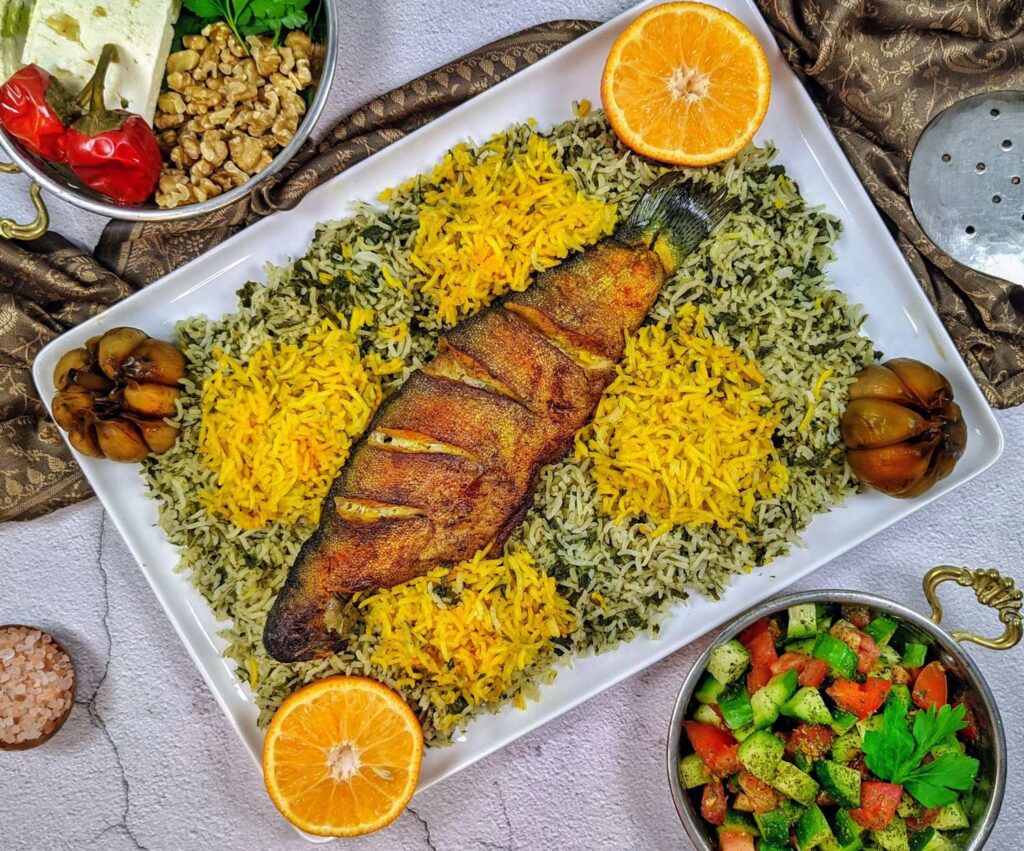
For the Persian New Year (Nowruz) celebrations it is traditional to serve Sabza Polo as rice dish with fish – traditionally fillets of smoked white fish from the Caspian Sea. However, fresh fish is now widely available.
In Northern Iran, the fish is marinated with lemon juice and saffron and then fried to perfection, while Southern Iranian culinary traditions favor stuffing the fish and baking it.
This rice perfectly complements Persian food, serving as the ideal accompaniment to both fish and meat dishes.
Sabzi Polo Ingredients
- 2 cups basmati rice
- Salt
- 8 cloves garlic
- Vegetable oil
- Smidgen ground saffron
- 1 package frozen Sabzi Polo
- 2 Tbsp dried dill weed
5. Kabab Koobideh: Best Persian Food
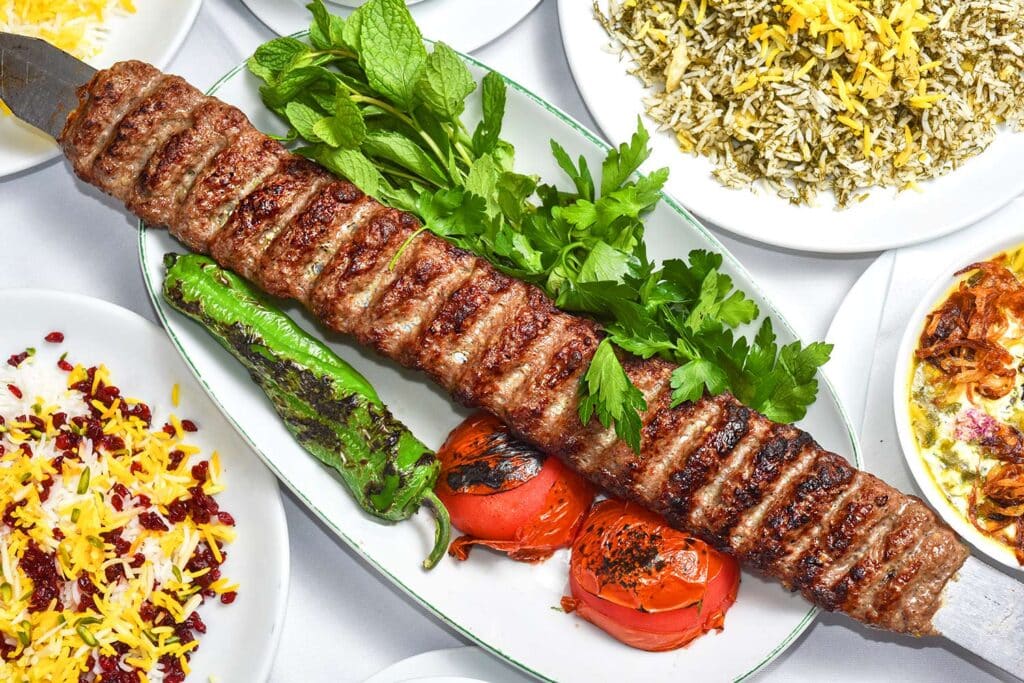
Kebab or Kabab, especially Kabab Koobideh, stands as the famed traditional Persian food, deeply loved throughout Iran.
Kabab Koobideh is the most popular Persian food, especially among foreign travelers exploring Iranian cuisine. This dish is famous for its distinct flavors and authentic preparation. Travelers love its unique taste, making it a top choice in Persian cuisine.
In the realm of Persian food, kebabs offer an impressive variety. Take Koobideh, for instance: ground meat seasoned with minced onion, salt, and pepper. The result is a taste sensation that’s simple yet sublime. Then there’s Kebab-e Barg, featuring thinly sliced lamb or beef, enlivened with lemon juice and onion, and enriched with a saffron and butter baste.
Joojeh, the traditional chicken kebab, usually uses the whole chicken, bones included, to intensify its flavor. While American restaurants might opt for skinless chicken breasts, the authentic method involves marinating the chicken in lemon and onion, then basting it with saffron and butter. Let’s not forget Jigar, the lamb liver kebab, a true delicacy often garnished with fresh basil leaves and served with a lemon wedge.
Kabab Koobideh: Key Persian Food Ingredients
- 3 lbs (1360 g) Ground Beef (85% Lean)
- 2 Small Onions
- 1 Tbsp (Approximately) Salt or as preferred
- 1 Tsp (Approximately) Black Pepper Powder or as preferred
- 1 Tsp Turmeric
- 1 Tsp (Approximately) Ground Sumac.
- 1/4 Tsp Saffron
6. Khoresht-e Gheimeh
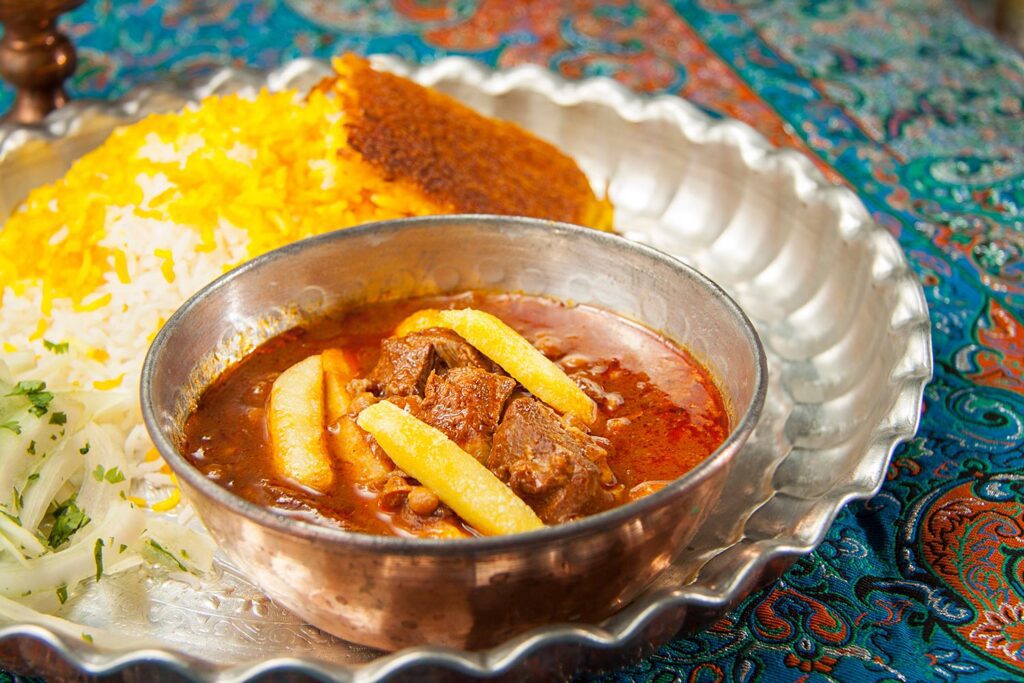
Before the introduction of electric fridges, families in the colder, northern provinces of Iran such as Azerbaijan devised ingenious ways to preserve meat for consumption during the winter months.
Small pieces of meat, referred to as gheimeh, are fried with onions, seasoned with turmeric and other spices, and then stored in large earthenware vats. To protect against microorganisms, a solid layer of fat solidifies on top, sealing the contents. These vats find a home in cool, dark basements during the winter months.
Each day, a portion is scooped out to enhance the khoresht. Khoresht-e gheimeh consists of diced meat mixed with yellow split peas, dried limes, saffron, and fried potatoes.
This popular Persian food enjoys widespread popularity throughout Iran and is a staple year-round. Paired with rice, the combination of meat and pulses offers a wholesome meal. Khoresht-e Gheimeh is one of the top Persian foods in Iran.
Khoresht-e Gheimeh Ingredients
- 100 g/3½ oz. yellow split peas
- 1 medium onion
- 4 dried limes
- 300 g/11 oz. leg of lamb
- 50 g/2 oz. butter
- 4 tablespoons vegetable oil
- 2 teaspoons turmeric
- 2 teaspoons powdered dried lime
- Salt and black pepper
- 1 litre / 1¾ pints boiling water
- 1 tablespoon tomato purée/tomato paste
- 2 tablespoons lemon juice
- 2 tablespoons liquid saffron
7. Tahchin: A Premier Traditional Persian Food
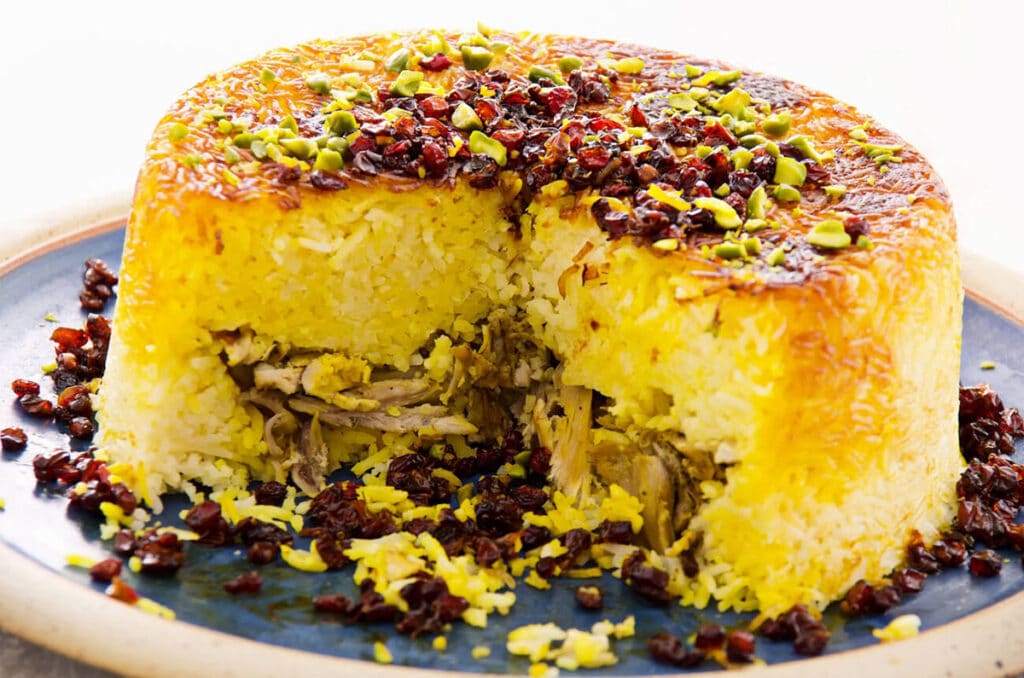
Tahchin, a savory Iranian rice cake within Persian cuisine and one of the best Persian meals, combines rice, yogurt, saffron, egg, and chicken fillets. You can also substitute chicken with vegetables, fish, or other meats to suit different tastes.
Tahchin consists of two distinct layers: The first is the thin Tahdig section at the pot’s bottom, which encompasses chicken fillets, saffron, and other ingredients. The second layer is the white rice. However, in many restaurants, Tahchin is primarily presented without the white rice component.
Tahchin Ingredients
- 600 g/1 lb. 5 oz. basmati rice
- 4 tablespoons salt
- 8 chicken pieces
- 1 large onion
- 4 tablespoons vegetable oil
- ½ teaspoon turmeric
- 3 tablespoons lemon juice
- 6 tablespoons liquid saffron
- Salt and black pepper
- 500 ml/just under 1 pint water
- 50 g/2 oz. butter
- 400 g/14 oz. Greek-style full-fat/whole milk yogurt
- 1 egg (optional)
8. Abgoosht: A Top Local Persian Food
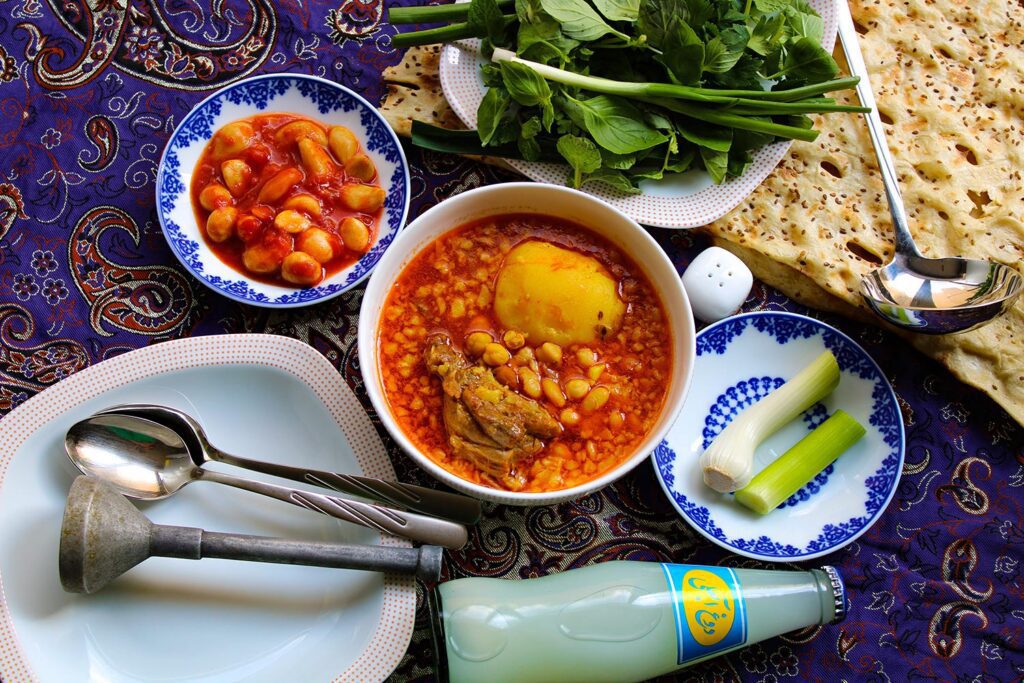
Explore the array of Persian foods with a dive into the world of Abgoosht, the quintessential Iranian stew that defines comfort food. This dish is perfect for cold weather, offering a nutritious blend of carbohydrates, proteins, and fats. Paired with fresh herbs and yogurt, it creates a fulfilling and robust meal.
From its modest origins as a meal for the less affluent, Abgoosht has become a cherished dish for family dining. Initially prepared with basic lamb cuts and fats, it was slow-cooked in clay pots at tea houses and caravanserais, nestled in the heat of wood stove ashes.
Abgoosht’s beauty is its regional diversity. The standard preparation includes chickpeas without tomato purée, while our recipe welcomes potatoes, red kidney beans, split peas, and a splash of tomato purée for a richer flavor profile.
The preparation of Abgoosht is straightforward but requires the slow fusion of its ingredients for full flavor. For best results, prepare it a day ahead until you add the red kidney beans. When it’s time to serve, reheat the stew, adding lemon juice and saffron for an aromatic and flavorful kick. Discover how to cook this Persian culinary staple and impress at your next gathering.
Abgoosht Ingredients: Key Elements of Persian Food
- 3 lbs (1360 g) Beef Shank
- 1 Can 15 oz. (425 g) Chickpeas
- 1 Can 15 oz. (425 g) White Beans
- 3 Garlic Cloves
- 1 Large Onion
- 5 Dried Limes
- 2 Bunches Cilantro
- 5 Small Potatoes
- 5 Small Tomatoes
- 1-2 tbsp Savory
- Turmeric, Black Pepper Powder, Salt
9. Mirza Ghasemi
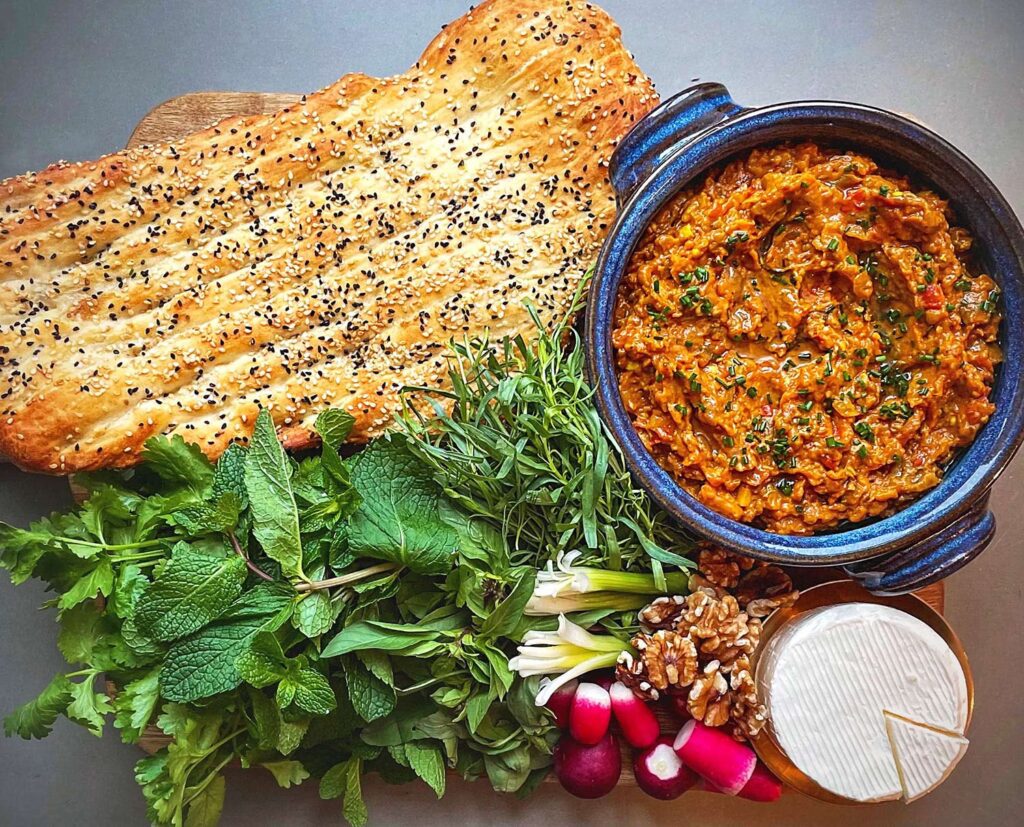
This mouth-watering local traditional Iranian food hails from the Northern regions of Iran, particularly Gilan province, known for its lush landscapes and culinary inventiveness. Mirza Ghasemi is a tantalizing blend of smoked eggplants, garlic, and tomatoes, graced by the flavors of turmeric and sometimes a hint of smoky saffron. This beloved vegetarian dish often appears on Iranian breakfast tables but is a treat that can be relished any time of the day.
Mirza Ghasemi Ingredients
- 2 large eggplants
- 4 cloves of garlic, minced
- 2 ripe tomatoes, finely chopped
- 1 teaspoon turmeric powder
- Salt to taste
- 2 tablespoons olive oil
- 2 eggs (optional)
- A pinch of saffron (optional)
10. Baghali Polo: A Unique Persian Food
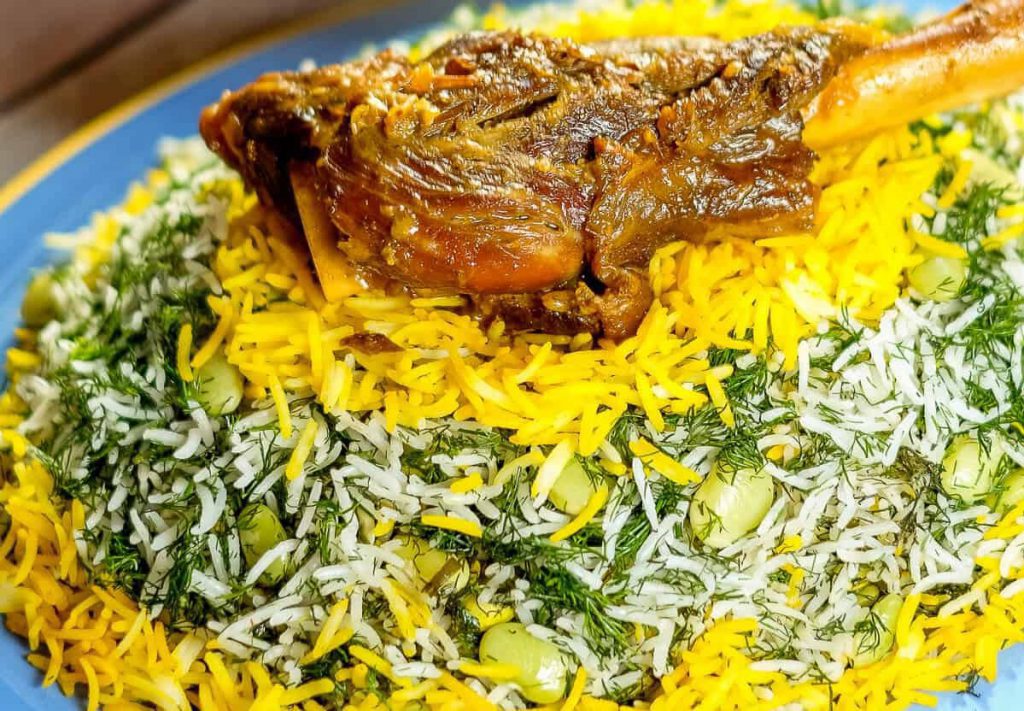
Baghali Polo, a staple in Iranian cuisine, marries the fragrance of Basmati rice with the fresh taste of dill and the satisfying bite of fava beans. This classic dish frequently pairs with succulent lamb or tender chicken, enhancing its rich profile.
Celebrated during Nowruz, Iran’s New Year festivities, Baghali Polo embodies the freshness of spring with its green-hued ingredients. This dish not only delights the palate but also represents the joy and renewal that spring brings to the Persian table.
Baghali Polo Ingredients
- 2 cups Basmati rice
- 1 cup fresh dill, finely chopped
- 1 cup fava beans, shelled
- 1 teaspoon saffron, ground and dissolved in water
- Salt to taste
- 2 tablespoons butter or ghee
- 1 tablespoon olive oil
Best Persian Cookbooks
Exploring Persian cuisine offers a delightful journey through a rich culinary heritage. Here are some top Persian cookbooks that bring the flavors of Iran right to your kitchen:
1. “Food of Life: Ancient Persian and Modern Iranian Cooking and Ceremonies” by Najmieh Batmanglij:
This comprehensive cookbook stands as a staple in Persian cooking. It combines traditional recipes with modern adaptations, accompanied by fascinating cultural insights and beautiful photography.
2. “Persiana: Recipes from the Middle East & Beyond” by Sabrina Ghayour:
Although not exclusively Persian, this book features a collection of Middle Eastern recipes with a significant number of Persian dishes. Ghayour’s approach is accessible and modern, perfect for cooks wanting to experiment with new flavors.
3. “The Saffron Tales: Recipes from the Persian Kitchen” by Yasmin Khan:
Khan brings to life the diverse cuisines of Iran through personal stories and recipes. This book offers a contemporary take on traditional dishes, making them approachable for home cooks.
4. “Joon: Persian Cooking Made Simple” by Najmieh Batmanglij:
Another gem from Najmieh Batmanglij, “Joon” focuses on simplifying Persian cuisine for everyday cooking without losing the essence of traditional flavors.
5. “Persian Cooking for a Healthy Kitchen” by Najmieh Batmanglij:
For health-conscious food lovers, this cookbook presents Persian recipes with a focus on fresh, natural ingredients and wholesome cooking methods.
6. “Bottom of the Pot: Persian Recipes and Stories” by Naz Deravian:
Deravian’s book beautifully intertwines family stories with authentic Persian recipes, providing an intimate look at the culture and its cuisine.
7. “The Enchantingly Easy Persian Cookbook: 100 Simple Recipes for Beloved Persian Food Favorites” by Shadi HasanzadeNemati:
Ideal for beginners, this book offers an easy approach to Persian cooking, with straightforward recipes that maintain the authenticity of the flavors.
Each of these cookbooks offers a unique perspective on Persian cuisine, from traditional dishes to contemporary adaptations.
The Bottom Line
Iranian cuisine offers more than just some Persian dishes; it’s an exploration of centuries-old culinary traditions that await your discovery. Each dish tells a story of the landscapes, history, and people of Iran. With flavors and ingredients as rich and diverse as its culture, Iranian food is an adventure for the palate, promising an authentic taste of Persia’s hospitality and heritage.
Whether you’re sampling the fresh herbs and tangy flavors of the Caspian Sea’s lush shores or the bold spices of the southern coast, the experience is bound to be unforgettable. So, plan your journey, book your travel or buy your travel services via OrientTrips with SURFIRAN, and prepare to indulge in a feast of senses. This is Iranian cuisine, where every bite is a passage through time and a celebration of flavor.
Persian Food: FAQs
The most popular Persian foods include Kabab Koobideh (minced meat kebab), Ghormeh Sabzi (herb stew), Fesenjan (pomegranate stew), Abgoosht (Meat and potato stew), and Tahchin (Iranian rice cake).
Persian food offers a delightful mix of flavors, often combining sweet, savory, and tangy elements. It’s known for saffron, pomegranate, fresh herbs, spices, nuts, citrus, and occasional floral notes from ingredients like rosewater.
Yes, meat, especially lamb, beef, and chicken, plays a prominent role in traditional Persian dishes. However, Persian cuisine also offers a variety of delicious Iranian vegetarian options for those who prefer plant-based meals.
Absolutely! Persian cuisine offers a wide array of dishes that cater to various dietary needs, including gluten-free, dairy-free, and nut-free options. Dishes like Kebabs, Ghormeh Sabzi (herb stew), and Kashk-e Bademjan (eggplant dip) can be easily adapted to meet your dietary requirements.
Persian cuisine known for its intricate blend of spices and herbs, such as saffron, turmeric, cinnamon, rose petals, and cardamom, which are combined with fruits like pomegranate and barberries to create a unique and delectable flavor profile.
Yes, Persian cuisine is rich in vegetarian and vegan dishes. Staples such as rice, fresh vegetables, lentils, and beans play a central role, with popular dishes including Ash Reshteh (noodle soup) and various types of Kookoo (herb and vegetable patties).
One of the most popular meals in Iran is “Chelo Kabab Koobideh,” which typically consists of skewered and grilled meat (often lamb, beef, or chicken) served with saffron-infused rice.
Persian foods are often made with fresh ingredients and cooked using methods that preserve their nutritional value. The cuisine includes a balance of proteins, fibers, and healthy fats, which contribute to a wholesome diet.
Cooking Persian food at home is a delightful venture. Start with staple ingredients like basmati rice and spices such as saffron. Recipes for classics like Tahdig and Fesenjan can be found online, or you can visit SURFIRAN’s magazine for detailed guides and authentic recipes.
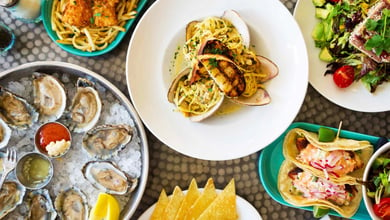



Thanks for this nice article about Persian food 🙂
Witch food exactly?
I’m persion girl
In my opinion khoresht _Ghormeh Sabzi and Fesenjon are the best
Thanks for this article! I Love Persian food! 😉
Persian food is wonderful
Persian food is very good and nutritious.
Of course, in addition to these foods, you can enjoy the taste of authentic Iranian and northern dishes by staying with women artists by staying in the eco-tourism resorts of the north.
Persian dishes are wonderful.
Regional Iranian dishes from the North and South of Iran are all delicious and are characterized by their herbal, bitter, sour and sweet nature.
Iranian cuisine is not spicy as this author erreneously has written. Iranians are quite literally known for not being able to handle spice.
Woww!!! the Persian foods are so interesting!! I love that
I’m from lran .oneof the intresting food in lran is Ash-e Doogh .
It’s very good.
I am from Iran and persian food is very good and my favorit food is ghormeh sabzi and Ash_e reshteh
my great grandma is the only one that can perfectly make all these dishes, if i follow these recipes do you think it’ll turn out the same as hers
try to follow what your grandmother does… each family has their own way of cooking these dishes. If you can not learn from her, look up various recipes of each dish…… the flavours are so subtle. GOOD LUCK!
hi alexa
I’m iranian.
Try typing the names of foods in Google in Persian and translating their recipes from Google Translator so that you can make food like us.
It is not widely used for foreign travelers in northern Iran, but in Mazandaran province and the city of Sari, which is located in the contemporary (Diwan forest) in northern Iran, you can see delicious food and the main flavors of the region and be sure. Which are not materials. The food of the people of this region is natural, local and healthy
It’s called Divan forest. The letter ‘w’ does not exist in Persian.
And all Persian dishes and Iranian cuisine are nutritious, healthy and delicious.
It’s called Divan forest. The letter ‘w’ does not exist in Persian.
And all traditional and regional Iranian dishes are characterized by their healthy, nutritious, delicious and natural nature.
I am Italian and I have tried Iranian dishes, it’s wonderful!
Italian foods are great
I realy realy like ti try Italian pizza!!!
Polo addass is another fragrant and delicious Persian dish…but if I had to pick the nation’s favourite dish it would have to be Ghorme-sabzi!!
Really
It’s called Addas Pollo not, “Pollo Addas”.
The Iranin dish is called called Addas Pollo, not ‘Pollo Addas’.
Nice! But Spanish foodies are much better and healthier!
If you had tried, you would never have said that.
totally agree 🙂
Never Compare Iranian Food With Other Countries , Iranian Food Are The Best Food That I Have Ever Tried
I love zereshk polo , It’s so delicious!
Hello
I am iranian man and thachin was better than all of them and you have to try kalam polo shirazi its the best foid in iran
Making Iranian foods are so hard but they are so tasty if you want to go past you should try them because they come from old culture
I have had the best Persian food made by a Persian woman. I think Americans are really missing out on some of the most fragrant delicious food ever! Full of flavor but not spicey.
I’m making Gormeh Sabzi today.
Hey I’m Persian anyway and yes you’re right it’s really cool that you have tasted these Iranian foods
Finally, some non-Iranian said it! Persian cuisine is NOT spicy.
Sour, bitter, herbal and sweet? YES!
But never spicy. Iranians are literally known for not heing able to handle spice.
Food rural and very good
BozGorme or Gavorme
It is prepared with meat
I really like Iranian food, I think it is delicious, I would like to try it
Of course that you must try you gonna like them
Salam I really L O V E LOVE iranian foood bc I’m from I R A N IRAN but born in A M E R I C A AMERICA aka Los Angeles but I love Iranian food ,such as polo gheime,polo ghormesabzi,reshte polo and tahdik
What an introduction this article had, only further contributing to ‘ .
“From the earliest times Persians have been known for their hospitality, whether that of the offering rest and refreshment to a weary traveler, or that of the urbane city dweller offering a sumptuous repast to his guests.”
? Iranian civilization is – and -. It has been that way since the time of the rule of the , the first Persian Empire 2500 , by the way.
“Persia’s geography, history and cultural influences have shaped the diversity of ingredients and the methods of cooking in one of the world’s oldest and most sophisticated cultures.”
. There are – found in Iranian cuisine or culture.
More like the opposite way around: .
Iran is a country located on the . No other country in the region is.
“Persia – or Iran – has been subjected to repeated invasions, but it has maintained its culture, language and identity throughout the centuries.”
You even answered this insincere statement yourself, when you stated the obvious:
“Accounts of early travelers to Iran indicate that the dishes served appreciably .”
.
Invaders come and go. They only function as a minority elite group ruling over a majority native population. Their existence as Persia’s ruling force never changed Iran’s cuisine, people, language, culture or traditions. ‘ ‘ .
“The resulting cuisine is more complex in taste than in the north of the country, with long notes of spices, tamarind and .”
Some rare regional dishes do not represent the overall Iranian cooking culture.
.
Iran’s cuisine is the complete opposite to anything spicy.
, , , .
That is literally what Iranian dishes are internationally known for.
– – .
I’d like to adjust or correct from the introduction of this article:
“From the earliest times Persians have been known for their hospitality, whether that of the tribesman offering rest and refreshment to a weary traveler, or that of the urbane city dweller offering a sumptuous repast to his guests.”
Tribesman? Iranian civilization is non-clanic and non-tribal. It has been that way since the time of the Persian Achaemenids 2500 years ago, the first Persian Empire.
Tradition requires that guests or visitors be served only the finest food available, and always in the most bountiful manner possible. Accounts of early travelers to Iran indicate that the dishes served have not changed appreciably over the centuries.
“Persia’s geography, history and cultural influences have shaped the diversity of ingredients and the methods of cooking in one of the world’s oldest and most sophisticated cultures.”
There are no non-native or foreign elements to be found in Persia’s ancient culture or cuisine.
Culinarily, all the ingredients to prepare Iranians dishes with are native to the Iranian Plateau.
Geographically, Iran is a Western Asian country located on the Eurasian Plate.
No other country in the region is located on the Eurasian Plate which explains Iran’s uniqueness in terms of culture and cuisine.
Iran is a Plateau, hence the entire country is covered in mountains.
The mountainous Iranian Plateau has functioned as a natural fortress against invaders, especially from the South with the help of the Iranian Zagros mountain range.
“Persia – or Iran – has been subjected to repeated invasions, but it has maintained its culture, language and identity throughout the centuries.”
I mean this bizarre statement has been already answered a few lines above by the article itself:
“Accounts of early travelers to Iran indicate that the dishes served have not changed appreciably over the centuries.”
Nothing changed basically.
Invaders come and go. What remains are Iranians, Iran’s ancient civilization and Iranian culture.
Invaders in Persian history only functioned as a minority elite group ruling over a majority Iranian population. They had no influence on Persian culture, cuisine or traditions. This should give one a basic idea on Iran’s strength as an ancient civilization.
“The northern regional cuisine features simple, fresh notes of taste and aroma, and there is a preference for sweet and sour flavours, as opposed to spicy.”
Iranian cuisine is characterized by its herbal, sweet, sour and bitter nature. It is never spicy. Iranians are literally known for not handling spice.
“The resulting cuisine is more complex in taste than in the north of the country, with long notes of spices, tamarind and chillies.”
Not true at all. Southern regional Iranian food is still not spicy just like counterpart in the North.
I would suggest to revise the introduction of this article.
I just want say how can you not have jojeh kabab on this list. Iranians are the best in the world in making chicken. Now we are bad at everything else except for chicken kabab, for jojeh kabab not make this list is a crime.
honestly you are so right
Berioon, khooresht most, and lot of testy food in esfahan
You can it them
There are perfect!
Food rural and very good
BozGorme or Gavorme
It is prepared with meat
well , its Khoresh , not khoresht
Both are right
Hey
There’s no difference!
We can say either khoresh or khoresht.
Even persian people (we) use both words.
I want a thank parsa to explain exactly what the Persian civilization existed.. thank you again..
Born to eat Abghoosht. In fact it is what I live for.
Abgousht has its own unique world. Its interesting that the traditional Abgoosht doesn’t have any potatoes, tomatoes, or tomato sauce. Those ingredients only made their way into Abgousht in the past couple centuries. You can still get your hands on some really authentic and traditional Abgousht in Tehran. So if you’re ever in the area, give it a try!